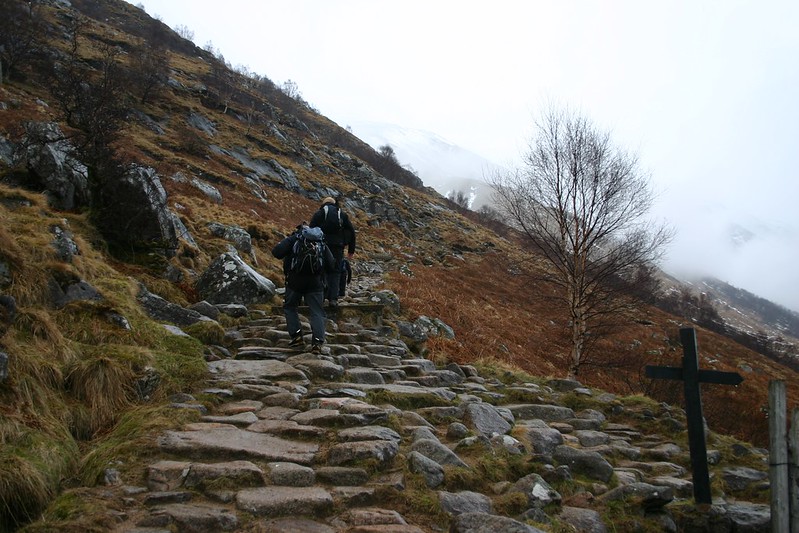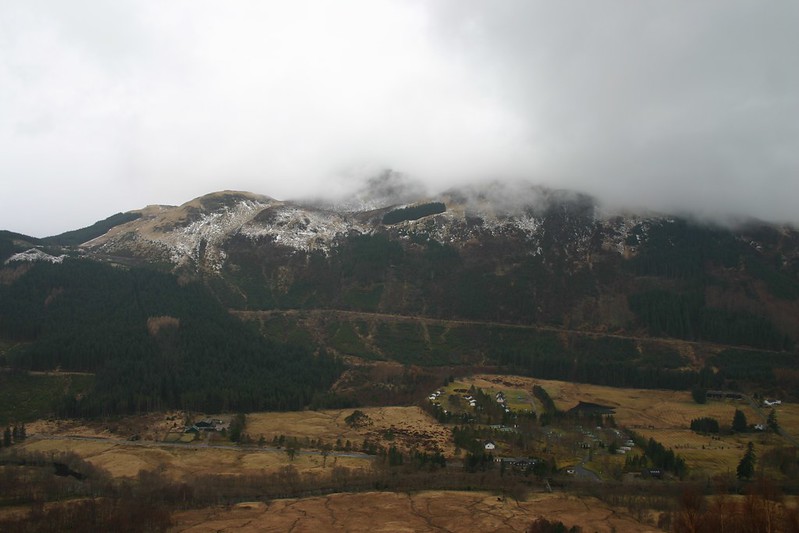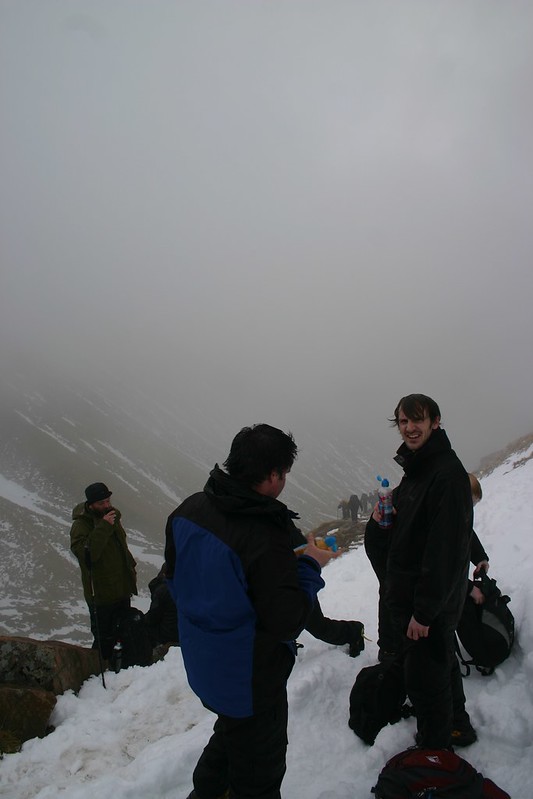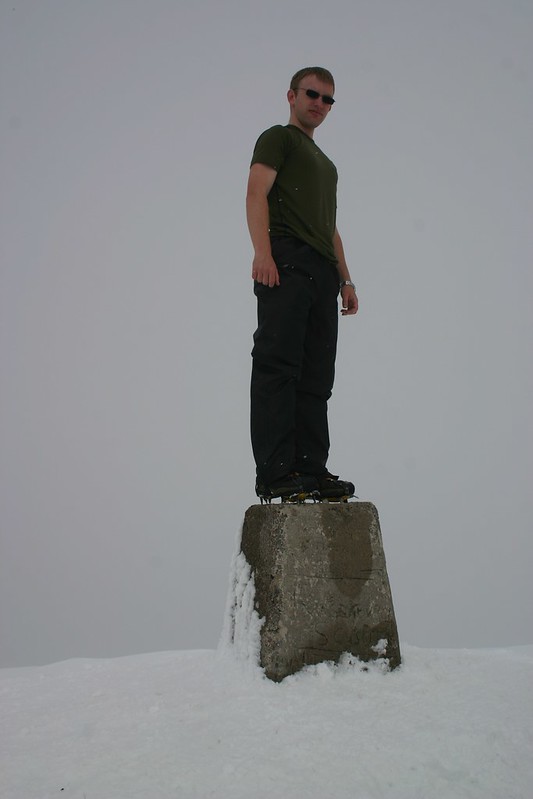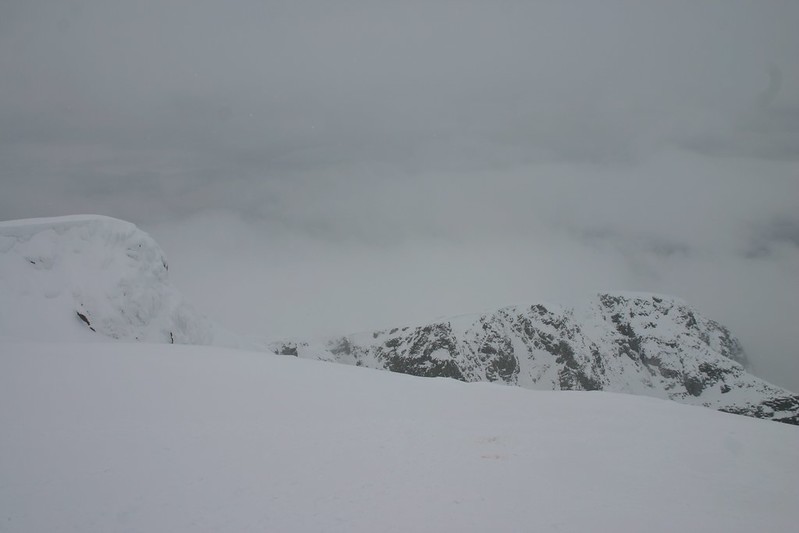So the morning came and after a good fried breakfast we met up with our guide who was going to take us to the summit. Where the previous day had been nice and sunny this day was already cold and wet. We didn’t let this dampen our spirits though – we were about to climb a mountain! The other guys had some experience from doing some minor peaks around England but nothing that high over the previous weeks, and one had done Ben Nevis before – I think I may have been a little more prepared for bad weather conditions though due to me having done Mount Tongariro the week before.
The start of the climb is quite easy and can be done in normal walking gear – walking boots, gaiters, etc. but eventually we got to places with increasingly more snow. After about an hours walking we finally got to a point where we needed crampons to proceed any further. My first attempt at fitting them wasn’t too bad, but my mistake was in what to do with the excess material from the straps when they’re pulled tight. I knew it’d be dangerous to have it tucked away somewhere, but the best way is to actually tuck them inside your gaiters as they should hold it in place. It’s a little strange walking in them at first, but as we reached deeper and deeper snow it became more comfortable to walk in them.
At some points the path did get quite narrow but with the crampons on it didn’t really worry us as they do provide pretty decent grip. Along the path we took stops every now and then so that the ones who were lagging behind could stop and rest which did mean it took longer to do the climb but it gave the sun time to break through the clouds. It was kind of an eerie atmosphere – it was predominantly cloudy but you couldn’t feel any wind so it was actually quite warm despite all the snow.
After we’d been walking across snow for some time there had been instances where it wasn’t clear where the path was and stepping off the path meant you’d suddenly find yourself knee-deep (or deeper) in snow. It was round about this time when the guide started to show us a few basic skills for climbing mountains in the snow. The first one was an avalanche test:
You use an ice pick to dig out a square area as deep as you can, making sure that you leave part of the snow and ice in the middle standing. The idea then is to gradually put more weight onto the snow and to see how much strength you need to break it. If the snow at the top breaks easily then there’s a real chance of an avalanche. The reasoning behind this is that when the temperature warms slightly it will start to weaken the bonds between the snowflakes on the top layer; as it freezes again it will not be as strong as it was previously so will not take as much weight. When snow then falls on this thin layer of ice it becomes a risk that the weight of the snow, or people walking on it may then cause the sheet to move.
What was fairly off-putting at this time was that it did break suggesting that an avalanche was possible, but the guide merely shrugged his shoulders and exclaimed that he hadn’t seen it do that before. Moving on we eventually got to the halfway point where there is a narrow passage with steep, snow-covered sides – this is where he decided to do a few more skills such as the various ways you can stop yourself from sliding in the snow. When you’re wearing crampons you have to be extremely careful about sliding as they can easily get a grip without warning (as you’re falling) and will then break your leg from the force.
As we neared the top the snow got heavier and we encountered frequent changes in the visibility. One minute you could be shrouded in fog that stopped you seeing more than about 10 metres in front of you, and the next you’d be squinting from the sun reflecting off the snow. The climb does get harder near the top and it’s wise to stick to the area marked out by chevrons due to the number of gullies and cliff faces that are not easily seen.
As we approached the summit there was one last gulley which we almost walked off (well I say we, it was mainly just me that almost fell off) due to the guide getting mixed up with where the hidden gulley was located. Apparently he has fallen down it once before and was saved only by his quick thinking and having an ice pick to stop himself.
Upon reaching the summit of Ben Nevis it still felt like an achievement despite it not being the highest I’d climbed, it was more of an adventure having an incredible amount of snow and having achieved it with some friends. At the top it was deathly calm with no wind whatsoever which actually made it quite warm (hence me being in my base layer only by that point). The guide did comment that it’s extremely rare to not have wind on top of the mountain.
At the top there were quite a few people there, one group even had a bottle of champagne which they offered to us after they’d had their fill of it. After about 30 minutes at the summit pausing for a drink and a bite to eat we begun our descent. It was of course far quicker to get back down, but in places this also made it more dangerous due to how easily you could slip despite the crampons.
The extra strain this put on our feet and knees made it gradually more and more uncomfortable despite having “blister proof” socks. Eventually we got back down below the majority of the snow and removed our crampons.
What came next is probably the part which was the most fun. To avoid the icy path that looked quite dangerous we cut across the side of the mountain by sliding on our backs down the slopes. After several of these I finally decided I should be recording this on my iPhone so made sure I went off to the side slightly so I could record those that followed me. Sadly when I landed I found myself buried up to my waist in the snow, but it was a good position to get some shots of the slope. It wasn’t as steep as the previous two, but it was still fun.
About half an hour to an hour after that we finally reached the bottom (and the pub) having completed our first mountain of the Three Peaks Challenge. Once we’d finished at the pub we then got on the road and started the drive to the next peak in Yorkshire, Scafell Pike.
